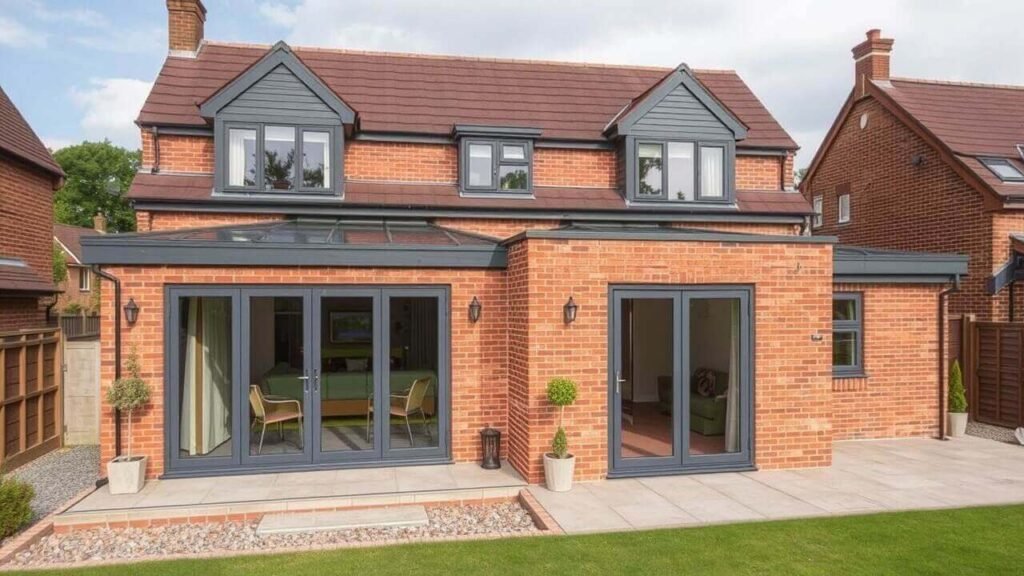Can You Build a House Extension Without Planning Permission? Here’s What You Need to Know
Dreaming of expanding your home without the hassle of a full planning application? Good news, under certain conditions, you can build a house extension without planning permission, thanks to what’s known as permitted development rights.
However, there are specific rules and criteria that must be met to qualify for this. It’s essential to understand these regulations to ensure your project goes smoothly and stays within legal boundaries.
At BritBrick Construction, we’re here to guide you through:
- How to build a house extension without planning permission
- The advantages of extending without needing permission
- Key conditions you need to meet
- What to consider about indemnity insurance
- Insights on the larger home extension scheme
Why Consider Extending Without Planning Permission?
Permitted development rights offer several advantages:
- Clear Guidelines: These rules provide a straightforward framework, so you can design your extension with confidence, knowing what’s allowed.
- Reduced Risk: By working within permitted development, you’re less likely to encounter unexpected costs or delays from planning applications.
- Ideal for Challenging Areas: If you live in an area where planning permissions are frequently denied, permitted development offers an alternative route.
- Focused Design: These pre-set regulations help streamline your design process, giving you a solid starting point for your project.

Essential Conditions for Extending Without Planning Permission
Before you start your project, consider these three crucial conditions:
Previous Extensions: Has your property been extended since 1948? If you or a previous owner has already extended the house after 1st July 1948, further extensions without planning permission may not be allowed.
Listed or Designated Land: Is your home listed or located in a conservation area? Properties on designated land, such as conservation areas or areas of outstanding natural beauty, may have limited or no permitted development rights. In such cases, seeking expert advice is highly recommended.
Property Type: Is your property a house or a flat? Permitted development rights apply only to houses, not to flats or maisonettes. If your house has been converted in the past, additional restrictions may also apply.

What Was the Larger Home Extension Scheme?
The larger home extension scheme, which ended in 2020, once allowed for bigger single-storey rear extensions than standard permitted development rights. Although the scheme has been dissolved, its allowances are now integrated into permitted development rights. Today, if you want to build a larger extension, you simply need to apply for prior approval. This allows you to extend a detached house by up to 8 metres or other types of houses by up to 6 metres.

Permitted Development Rules for Different Extensions and Renovations
The UK’s Town and Country Planning (General Permitted Development Orders) 1995 sets out specific rules for what changes you can make without needing planning permission. Here’s a breakdown:
General Extension Rules:
- Land Use: Your extension cannot cover more than half the land surrounding the original building.
- Height: The extension cannot be taller than the highest part of the existing building.
- Proximity to Highways: Extensions close to a highway may require special consideration.
- Eaves Height: The eaves must not exceed 3 metres if the extension is within 2 metres of the boundary.
- Materials: The materials used for the extension must closely match those of the existing house.

Attached vs Detached Properties:
- Attached Homes: Extensions should not extend more than 3 metres beyond the rear wall.
- Detached Homes: Extensions can extend up to 4 metres from the rear wall.
Single Storey Extensions:
- Detached Houses: May extend up to 4 metres in height.
- Other Properties: May extend up to 3 metres in height.
Two Storey Extensions:
- Roof Pitch: Must match that of the original house.
- Windows: Side-facing first-floor windows must be obscure-glazed and non-opening unless the open window is at least 1.7 metres above floor level.
Front Extensions:
Permitted development allows you to extend the front of your home as long as:
- Single Storey: The extension is a single storey.
- Proximity to Road: It doesn’t front onto a road.
- Size: It doesn’t extend more than 3 metres from the original house.
Porch Extensions:
- Height: Must not exceed 3 metres.
- Boundary Proximity: Should be at least 2 metres from any boundary next to a highway.
- Ground Area: Must not exceed 3 square metres.
Rear Extensions:
- Single Storey: Extensions can extend up to 4 metres for detached houses and 3 metres for other properties. With prior approval, these can increase to 8 metres and 6 metres, respectively.
- Double Storey: Can extend up to 3 metres from the original house, provided they are more than 7 metres from the rear wall.
Side Extensions:
- Height: Must be a single storey and not exceed 4 metres in height.
Basement Conversions:
You can convert your basement without planning permission if:
- No Separate Unit: It is not converted into a separate unit.
- No Excavation: There is no excavation to form a new basement.
- External Appearance: The external appearance is not significantly altered, for example, by adding a lightwell.
Replacing Windows:
Planning permission is generally not required to replace windows, provided the new windows are similar to the existing ones.
Internal Walls:
You usually don’t need planning permission to knock down internal walls unless your home is listed or in a conservation area.
Rooflights:
Permitted development covers rooflight installation if:
- Projection: The rooflight does not project more than 15 cm from the roof’s slope.
- Location: It is not installed on a side elevation facing a highway.
- Height: If placed on a side elevation, it must be non-opening or more than 1.7 metres above floor level.
Loft Conversions:
- Cubic Content: Must not exceed 40 cubic metres.
- Dormer Windows: Must not extend higher than the highest part of the existing roof or project forward of the roof plane on the main elevation.
Garage Conversions:
Most garage conversions are covered by permitted development, provided the work is internal and doesn’t involve enlargement. Detached garages may require you to check with local authorities to ensure your home’s permitted development allocation hasn’t been used up.
Conservatories:
Conservatories follow the same rules as house extensions. They must not exceed the height of the main house or occupy more than half the surrounding land.
Sheds and Garden Rooms:
These generally fall under permitted development. Key points include:
- Height: Maximum eaves height of 2.5 metres.
- Use: Cannot be used for residential accommodation like bedrooms.
Fences and Walls:
- Height Limits: Up to 1 metre when adjacent to a highway, or up to 2 metres elsewhere.
Swimming Pools:
Permitted development allows for garden swimming pools, provided they do not take up more than half of the garden area.
Solar Panels:
Solar panels are permitted if they do not protrude more than 200 mm from the roof or wall and do not extend above the highest part of the roof.
By following these rules, BritBrick Construction can help you expand your home without needing planning permission. Always check with local authorities and consider professional advice to ensure your project complies with all legal requirements.
Your Dream Home Awaits
Connect with BritBrick Construction and take the first step towards creating the perfect space for you and your family. Let’s build something extraordinary together!


